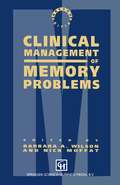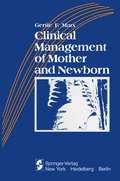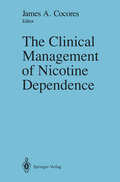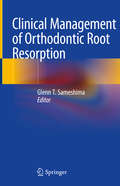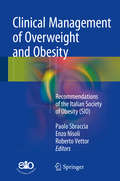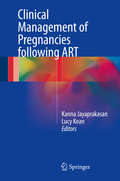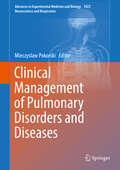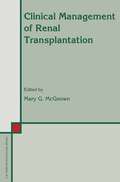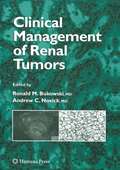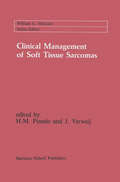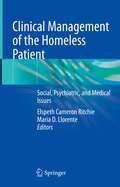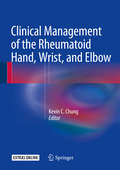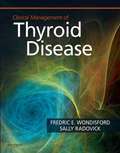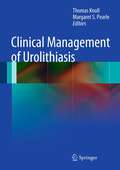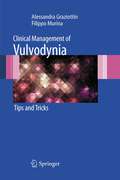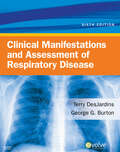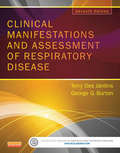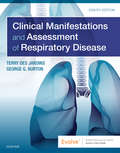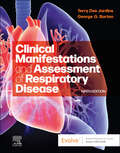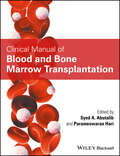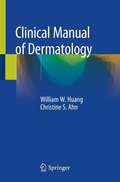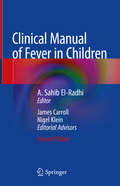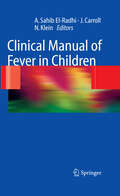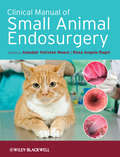- Table View
- List View
Clinical Management of Memory Problems (Psychology Library Editions: Memory Ser.)
by Nick Moffat Barbara A. WilsonClinical Management of Mother and Newborn
by Gertie F. MarxThe birth of a baby is the culmination of months of anticipation and plan ning. Most often, mother and infant are healthy and readily able to estab lish close contact-a bond. However, in some situations either mother or baby or both present complications. The more prompt and rational the treatment, the sooner the normal parent-infant relationship will commence. This book is devoted exclusively to the first days following birth. In its 15 chapters, postpartum and postnatal physiology and pathophy[ i:.;logy are reviewed by 18 specialists. Normal and abnormal development of mother and child is correlated with proven means of clinical management. Chapters 1 through 3 cover maternal postpartum developments and complications. Chapter 4 stresses the importance of a normal parent newborn relationship, a concept of increasing concern in modern society. The following ten chapters discuss neonatal physiology and pathophysi ology; the effects of obstetric anesthesia on infant behavior, pulmonary function measurements in the postnatal period and treatment of the sick newborn are discussed in detail. The final chapter reviews maternal and perinatal mortality; the data, based on extensive surveys in New York City, indicate that current management is effecting an overall decline in mortality.
The Clinical Management of Nicotine Dependence
by James A. CocoresThe 1980s have. seen a remarkable degree of public and professional acceptance of cigarette smoking as the most widespread and devastating form of drug dependence. More medical schools now give required courses about drug dependence. Prestigious journals publish reports of investiga tions on the subject of nicotine dependence, and more conferences and workshops are held each year on various aspects of nicotine dependence. All this is in sharp contrast to the earlier prevailing atmosphere of dis interest, ignorance, or professional disdain. These changes created an obvious place for a textbook oriented pri marily toward the needs of clinicians working with patients who have nicotine dependence. Thus, in preparation of this book, most aspects of the management of nicotine dependence are incorporated, in order to address concerns of physicians in training and other health care profes sionals across the world. The final product, which I believe to be com prehensive and clinically relevant throughout, is a text that I hope will be of equal use to psychologists, social workers, nurses, counselors, and physicians in all specialties. An encyclopedic treatise was deliberately avoided because that approach can be cumbersome in size, readability, and cost, and for that reason, readers will find little mention of data involv ing animal research, nicotine-related politics, nicotine product advertising, medical consequences of smoking, psychotherapeutic techniques, and the extent of the problem.
Clinical Management of Orthodontic Root Resorption
by Glenn T. SameshimaThis book is exceptional in being dedicated solely to root resorption caused by orthodontic tooth movement. While the core content is based on scientific evidence, the book is intended as a practical aid for the clinician who performs orthodontics. After explanation of the different types of root resorption, a series of clinically oriented chapters focus particularly on external apical root resorption. Readers will find clear guidance on etiology, risk factors, diagnosis, imaging, patient management and education, and treatment options. The long-term prognosis of teeth with resorbed roots is thoroughly discussed, and advice is provided on the measures that should be adopted if severe root resorption is encountered during or at the end of treatment. Valuable information is also presented on the practice management side of the problem, covering informed consent, record keeping, and documentation of risk. The closing chapter examines likely future directions in root resorption management. The principal author has lectured and published on the subject for more than 25 years and is internationally recognized as a leading authority. This is the FIRST book solely dedicated to orthodontic root resorption!
Clinical Management of Overweight and Obesity: Recommendations of the Italian Society of Obesity (SIO)
by Paolo Sbraccia Enzo Nisoli Roberto VettorThese guidelines make recommendations regarding the management of individuals with a body mass index greater than 25.0 kg/m2 and cover all age groups, from children to the elderly, as well as various patient subsets. A range of measures to yield health benefits are set out, including healthy eating plans, increased physical activity, and behavioral modifications to help patients to manage obesity. In addition, recommendations are made on the use of bariatric surgery and the new antiobesity drugs. Throughout the process of developing the recommendations, every attempt was made to ensure use of a rigorous, evidence-based approach. The guidelines are promoted by the Italian Society of Obesity (SIO) and were formulated in compliance with a prespecified process overseen by a steering committee. They are intended for use by a wide range of clinicians, including general practitioners, primary health care nurses, and primary health care professionals, and will hopefully prove of value in combating the obesity epidemic not only in Italy but across Europe and elsewhere in the world.
Clinical Management of Pregnancies following ART
by Kanna Jayaprakasan Lucy KeanThis book provides a detailed overview of the possible risks associated with ART pregnancies and their clinical management. While most pregnancies following Assisted Reproduction Treatment (ART) will progress normally and without any complications to mother or baby, some women who conceive after ART as well as their babies are at increased risk of pregnancy complications. There are some schools of thoughts proposing pregnancies following IVF should be regarded as being “high risk” and requires special attention. There are various reasons why ART pregnancies may be at higher risk – Female and male age factor, increased chance of multiple pregnancies, underlying cause of subfertility (pelvic pathology, uterine pathology, endometrial dysfunction) and potential increase in birth defects. This is an essential read for obstetricians, fertility specialists and Post-graduate trainees.
Clinical Management of Pulmonary Disorders and Diseases (Advances in Experimental Medicine and Biology #1022)
by Mieczyslaw PokorskiThe book endeavors to provide a stimulating and thought provoking scientific content to share and exchange new clinical studies and advancements in dealing with pulmonary diseases. The topics vary from clinical to translational research in respiratory diseases such as lung cancer, obstructive sleep apnea, chronic obstructive pulmonary disease, bacterial and fungal infections, lung lesions during febrile maladies, and others. An attempt has been made to show the intertwined relationship between the pulmonary system and other body systems such as kidney, cardiac, or hormonal functions. The ensuing interlocked morbidities, often exacerbating one another, require the coordination of various medical specialties to optimize the diagnostic and therapeutic processes. The knowledge sharing through publications of research and clinical experiences is indispensable to accelerate the innovation spectrum and to continue working on the therapeutic and preventive strategies in chronic pulmonary diseases. The book is addressed to pulmonologists, chest physicians, researchers, and healthcare professionals engaged in patient care.
Clinical Management of Renal Transplantation (Developments in Nephrology #32)
by Mary G. McGeown CBEClinical Management of Renal Transplantation presents The Belfast City and University Hospital experience in renal transplantation. Over the years, the Belfast Renal Transplant Unit has acquired considerable experience in all aspects of renal transplantation which have led to excellent results. The team working in the Belfast Renal Transplant Unit has built up an outstanding reputation which has become widely known. This volume is a comprehensive, practical reference work for senior medical students and nurses as well as for the established nephrologist and transplantation surgeon. It provides a clear and concise picture of the care needed by patients who are being prepared for renal transplantation or who have recently received a kidney transplant.
Clinical Management of Renal Tumors
by Ronald M. Bukowski Andrew NovickThis volume provides an in-depth review of the data relating to the management of renal tumors as well as an updated description regarding pathologic and molecular classification of renal tumors. The neoplasms covered include clear cell carcinomas, papillary cancers, nonepithelial tumors, and other mass lesions that resemble tumors. The management of patients with renal cancer having localized or advanced disease is discussed. Surgical approaches for primary and metastatic tumors, symptom palliation, and systemic therapy for metastatic disease including immunotherapy and targeted approaches are discussed in detail.
Clinical Management of Soft Tissue Sarcomas (Cancer Treatment and Research #29)
by J. Verweij H. M. PinedoAlthough soft tissue sarcomas are rare tumors, representing only ± 1 % of all malignant tumors in adults, they remain a challenge to all disciplines in medical treatment and research. Apart from research in all fields of treatment, soft tissue sarcomas are also encountered in several forms of combined modality treatment. Since the appearance of the first volume on soft tissue sarcomas in this series (Soft Tissue Sarcomas, Laurence H. Baker, ed., Martinus Nijhoff Publishers, 1983), a large amount of data has emerged from preclinical as well as clinical in vestigations. The present volume provides an up-to-date review of the state of the art without duplicating the contents of the earlier volume. In the chapter on pathology it is again indicated that malignant fibrocytic hys tiocytoma is at present the most frequently diagnosed type of soft tissue sarcoma. Nevertheless, sub-typing is less important for the prognosis than grade. Recently, grading has been defined better, permitting a more common use of this prognostic factor. However, the experience of the pathologist is most important for adequate grading. The pathologist will need an adequate biopsy to perform his investiga tions. Cytology is not sufficient for diagnosis. However, for confirmation of metastatic lesions, cytology may provide enough information. Some new tools have been added to the equipment of the pathologist.
Clinical Management of the Homeless Patient: Social, Psychiatric, and Medical Issues
by Elspeth Cameron Ritchie Maria D. LlorenteThis volume highlights the socioeconomic concerns related to medical care for homeless patients and places them at the interface of common psychiatric and medical problems clinicians encounter. Written by experts in psychiatry and other medical specialties, this volume is a concise, yet comprehensive overview of the homeless crisis, its costs, and ultimately, best practices for improved outcomes. The text begins by examining the scope and epidemiology of the problem and discusses its costs. It then examines the best practices for both physical and psychiatric care before concluding with a section on working with special populations that have unique concerns across the country including LGBTQ, women, children, veterans, and aging adults. As the first medical book on homelessness, it is designed to cover a broad range of concerns in a concise, practical fashion for all clinicians working with homeless patients. Clinical Management of the Homeless Patient is written by and for psychiatrists, general internists, geriatricians, pediatricians, addiction medicine physicians, VA physicians, and all others who may encounter this crisis in their work.
Clinical Management of the Rheumatoid Hand, Wrist, and Elbow
by Kevin C. ChungThis book provides comprehensive coverage of the management and related surgery of the rheumatoid hand, wrist, and elbow. It provides a much-needed, authoritative discussion of the epidemiology, surgical techniques, and outcomes of rheumatoid surgery. The book begins by introducing important background concepts, and then goes on to present up-to-date details on pre and postoperative management, indications, and treatment options. Each section ends with case-based coverage of common clinical scenarios and features numerous illustrations that showcase the sequential approach in managing this disease. Clinical Management of the Rheumatoid Hand, Wrist, and Elbow has broad appeal for rheumatologists and primary care physicians, and will assist them in providing appropriate referrals for surgery consultations. It also serves as a valuable reference for surgeons treating and managing patients with this unique disease.
Clinical Management of Thyroid Disease E-Book
by Fredric E. Wondisford Sally RadovickClinical Management of Thyroid Disease is an exciting new book edited by Fredric Wondisford, MD—developer of the revolutionary new drug, Thyrotropin—and Sally Radovick, MD, with contributions from experts in the field. It fulfills the niche of a succinct, clinical resource to help you translate research into practice. This full-color volume offers valuable information on thyroid cancer and non-cancerous lesions, the effect of drugs on thyroid function, genetic disorders, and more in an accessible, easy-to-read consistent format.Presents the expertise of authors and editorial staff comprised of leaders in the field of thyroid research and clinical management for the best-qualified guidance on diagnosis and treatment. Provides a full-color, comprehensive approach that makes valuable information easy to locate and quick to read. Covers relevant topics applicable to all levels of training and expertise to serve as a detailed clinical reference on everything from the basic to the sophisticated. Captures research advances on hot topics such as thyroid cancer and non-cancerous lesions, the effect of drugs on thyroid function, and genetic disorders so that you can incorporate them into the way you treat patients.
Clinical Management of Urolithiasis
by Thomas Knoll and Margaret S. PearleA host of new technologies, techniques, and medical regimens have been introduced over the past 30 years for the diagnosis, management, and prevention of urinary calculi. These range from novel imaging procedures and medical expulsive therapy to interventional treatment options. The contemporary urologist should be familiar with and adept at implementing these new concepts and techniques. Clinical Management of Urolithiasis will serve as a practical guide to every clinically relevant aspect of urolithiasis and its treatment, both surgical and medical. In addition to providing up-to-date evidence-based recommendations regarding stone management, the book reflects the real-life experience of well-known international experts. Each chapter includes tables and algorithms that allow the reader easily to check the requirements for specific procedures and to translate them into clinical practice.
Clinical Management of Vulvodynia: Tips and Tricks
by Alessandra Graziottin Filippo MurinaChronic vulvar pain, or ‘vulvodynia’, is a common problem that can have a considerable impact on the wellbeing of patients. Despite being seen routinely in everyday clinical practice, it remains a neglected disorder that may take many years to diagnose.This book eases the way for physicians, including General Practitioners and Gynecologists, who are motivated to improve the lives of women suffering from vulvodynia. By offering a concise overview of the latest information on the diagnosis and management of vulvodynia, and its numerous comorbidities, in an easy to read, ‘tips and tricks’ format, the book empowers physicians to rapidly and effectively address the complex and sensitive issues surrounding the disorder.
Clinical Manifestations & Assessment of Respiratory Disease - E-Book
by Terry Des JardinsLearn to assess and treat respiratory care disorders! Now in full color, Clinical Manifestations and Assessment of Respiratory Disease, 6th Edition bridges normal physiology and pathophysiology to provide a solid foundation in recognizing and assessing conditions. Authors Terry Des Jardins and George G. Burton describe how to systematically gather clinical data, formulate an assessment, make an objective evaluation, identify the desired outcome, and design a safe and effective treatment plan, while documenting each step along the way. Unique coverage of Therapist-Driven Protocols (TDPs) prepares you to implement industry-approved standards of care. Unique! Clinical scenarios connect to specific diseases so you can better understand the disease and the treatment modalities used. Unique! A focus on assessment and Therapist-Driven Protocols (TDPs) emphasizes industry-approved standards of care, providing you with the knowledge and skills to implement these protocols into patient care. Case studies help in applying information to assessment and treatment. Overview boxes summarize the clinical manifestations caused by the pathophysiologic mechanisms of each disorder. End-of-chapter questions include multiple-choice, short answer, matching, and case studies to test knowledge and understanding, pointing out areas that might require further study. A glossary of key terms with definitions is included in the back of the book. Appendices offer easy access to information such as calculations, symbols, medications, and measurements, plus answers to selected case studies. A unique full-color design enhances content and shows realistic examples of diseases and conditions. Student-friendly features reinforce learning with chapter outlines, objectives, and key terms. A consistent presentation of disease information shows background, treatment, and assessment for each condition so you learn the material in a clear, cohesive manner. Over 15 additional case studies with answers are added to the companion Evolve website.
Clinical Manifestations & Assessment of Respiratory Disease - E-Book
by Terry Des Jardins George G. BurtonGet a deeper understanding of respiratory disease with Clinical Manifestations and Assessment of Respiratory Disease, 7th Edition. This popular, full-color text provides all the necessary tools you need to learn how to gather clinical data, formulate assessments, make objective evaluations, identify desired outcomes, design a safe and effective treatment plan, and document all the steps involved. Using easy-to-follow language and relevant clinical scenarios, this text gives readers a firm understanding of why certain treatment modalities are applied. And with a new chapter on respiratory failure and mechanical ventilation protocol, new information on electronic charting, and numerous updates in treatment and assessment added to nearly all the chapters, this new edition ensures you will be well-versed in all of the new issues affecting respiratory therapy.UNIQUE! Emphasis on clinical scenarios and critical thinking skills illustrates the causes of the clinical manifestations activated by specific respiratory disorders.UNIQUE! Focus on assessment and Therapist-Driven Protocols (TDPs) emphasizes industry-approved standards of care, providing readers with the knowledge and skills to implement these protocols into patient care.Case studies provide realistic examples of the respiratory therapist’s role in successful patient care and readers apply text information to clinical assessment and treatment. Self-assessment questions at the end of the text help readers personally assess their understanding of chapter material. Overview boxes summarize the clinical manifestations caused by the pathophysiologic mechanisms of each disorder.Student-friendly features reinforce learning with chapter outlines, objectives, key terms, and easy-to-follow language. NEW! New chapter on respiratory failure and mechanical ventilation protocol outlines the respiratory therapist’s role in regards to these protocols. NEW! New chapters on congenital diaphragmatic hernia and congenital heart diseaseNEW! Updated content on electronic charting offers the latest guidelines for collecting and recording respiratory assessments and treatment plans using an electronic health record.NEW! The most up-to-date content throughout ensures readers are well-versed in the latest assessment and treatment guidelines for various respiratory illnesses and injuries.NEW! Therapist-driven protocols (TDPs) information is now separated into two chapters to divide content between the basic treatment protocols and the protocols for mechanical ventilation and weaning from the ventilator.
Clinical Manifestations & Assessment of Respiratory Disease E-Book
by Terry Des Jardins George G. BurtonA realistic look at treating respiratory diseases! Clinical Manifestations and Assessment of Respiratory Disease, 8th Edition gives you a fundamental knowledge and understanding that is required to successfully assess and treat patients with respiratory diseases. Using a unique organization of material, this full-color text is divided into three distinct areas which show you how to first gather clinical data, then formulate assessments, make objective evaluations, identify desired outcomes, design a safe and effective treatment plan, and finally document all steps. With easy-to-follow language and relevant clinical scenarios, you will gain a firm understanding of why certain treatment modalities are applied. New to this edition is a chapter detailing Respiratory Insufficiency in the Patient with Neuro-Respiratory Disease, along with revised content which takes a deeper dive into latest developments, research, and practices and protocols in the treatment of respiratory disease.Revised content in the disease sections reflect the latest developments, research, and practices and protocols in the treatment of respiratory disease.UPDATED! Case studies on Evolve provide realistic examples of the respiratory therapist’s role in successful patient care and help you apply text information to clinical assessment and treatment. UNIQUE! Emphasis on clinical scenarios and critical thinking skills helps students understand the causes of the clinical manifestations activated by specific respiratory disorders.UNIQUE! Focus on assessment and Therapist-Driven Protocols (TDPs) emphasizes industry-approved standards of care, providing you with the knowledge and skills to implement these protocols into patient care.Overview boxes summarize the clinical manifestations caused by the pathophysiologic mechanisms of each disorder.Self-assessment questions at the end of the text help you to personally assess your understanding of chapter material. Student-friendly features reinforce learning with chapter outlines, objectives, key terms, and easy-to-follow language.NEW! Respiratory Insufficiency in the Patient with Neuro-Respiratory Disease chapter outlines the respiratory therapist’s role in regard to these protocols. NEW! Illustrations in designated chapters ensures you have a visual representation of disease processes, and the latest assessment and treatment procedures.
Clinical Manifestations & Assessment of Respiratory Disease - E-Book: Clinical Manifestations & Assessment of Respiratory Disease - E-Book
by Terry Des Jardins George G. BurtonA realistic look at treating respiratory diseases! Clinical Manifestations and Assessment of Respiratory Disease, 9th Edition gives you the fundamental knowledge and understanding required to successfully assess and treat patients with respiratory diseases. This foundation helps you learn how to systematically gather relevant clinical data; make an objective evaluation; identify the desired outcome and formulate an assessment; design a safe, appropriate, and effective treatment plan; and document all the steps involved. With this knowledge, you will understand the effectiveness of performing therapies and when to adjust therapy to a desired outcome. UNIQUE! Emphasis on clinical scenarios and critical thinking skills prepares you for real-world practice. UNIQUE! Focus on assessment and Therapist Driven Protocols (TDPs). UNIQUE! Overview boxes highlight the clinical manifestations for each disease. Logically organized content is written at a user-friendly, approachable reading level for ease of use and understanding. Case studies provide realistic examples of the respiratory therapy practitioner’s role in successful patient care. End-of-chapter self-assessment questions and answer key are available on the companion Evolve website. NEW! Clinical Connection boxes provide real-world clinical case studies in relevant chapters. NEW! An updated design and additional tables, boxes, and figures draw attention to key information. UPDATED! Content includes the latest developments related to SARS and COVID-19. UPDATED! Information on ventilators, usage, and protocols reflects current practice. NEW! QR codes in most chapters direct to additional outside content to enhance the chapter, including audio sounds and animations.
Clinical Manual of Blood and Bone Marrow Transplantation
by Syed A. Abutalib Parameswaran HariProviding the practicing and trainee hematologist with a practical and immediately applicable compendium of answers the Clinical Manual of Blood and Bone Marrow Transplantation covers the spectrum of the hematopoietic cell transplant specialty, in particular practical issues in transplant patient care, and the set up and functioning of a transplant program. Supplies the practicing and trainee hematologist with a practical and immediately applicable compendium of answers to clinical questions Covers the spectrum of the hematopoietic cell transplant specialty, in particular practical issues in transplant patient care, and the set up and functioning of a transplant program Contains concise chapters written with a focus on tables, algorithms and figures to aid rapid referral Benefits from expert contributions from an international authorship
Clinical Manual of Blood and Bone Marrow Transplantation
by Syed A. Abutalib Parameswaran HariProviding the practicing and trainee hematologist with a practical and immediately applicable compendium of answers the Clinical Manual of Blood and Bone Marrow Transplantation covers the spectrum of the hematopoietic cell transplant specialty, in particular practical issues in transplant patient care, and the set up and functioning of a transplant program. Supplies the practicing and trainee hematologist with a practical and immediately applicable compendium of answers to clinical questions Covers the spectrum of the hematopoietic cell transplant specialty, in particular practical issues in transplant patient care, and the set up and functioning of a transplant program Contains concise chapters written with a focus on tables, algorithms and figures to aid rapid referral Benefits from expert contributions from an international authorship
Clinical Manual of Dermatology
by William W. Huang Christine S. AhnThis manual provides an educationally focused and practically applicable resource for trainee dermatologists undertaking various dermatology board examinations. Concise, easy-to-follow chapters featuring relevant videos with editorial commentary aid the reader in developing an in depth understanding of a range of skin conditions and their management. Key concepts relevant to cutaneous neoplasms, fungal infections, dermatopharmacology, chemical peels, disorders of pigmentation and dermatopathology are all covered. Emphasis is placed on breaking topics down into modules, similar to that now taken by many dermatology board assessments for trainee dermatologists, aiding the reader easily access the content they need. Clinical Manual of Dermatology concisely describes many key concepts required to gain a thorough understanding of a range of topics in dermatology crucial to successfully completing dermatology board examinations. It is therefore, a valuable resource for all trainee dermatologists.
Clinical Manual of Fever in Children
by A. Sahib El-Radhi James Carroll Nigel KleinThis book discusses the latest scientific evidence related to fever and presents the principles of clinical practice, covering different types of fever and its possible complications. The book adopts a clearly defined, practical and effective approach to the management of fever, helping the clinician improve the care for the febrile child. The reader will learn about the guidelines on antipyretics and their side-effects and differential diagnoses, with problem-setting and solving as a case presentation.The second edition of this well-received book has been fully updated to include exciting new information of the pathogenesis of fever, including functions of interleukin and all the latest guidelines from NICE and Cochrane Library, as well as all the most up-to-date information and guidelines on febrile seizures.This reader-friendly reference on the disorders of body temperature in children covers the entire spectrum of subjects related to fever. It gives an overview of the best treatment options in order to achieve the best results. Containing a core message at the start of each chapter and with and a reader-friendly format this is an indispensable guide for paediatricians, family doctors and other professionals who are regularly consulted because of febrile children.
Clinical Manual of Fever in Children
by A. Sahib El-Radhi James Carroll Nigel KleinFamily doctors, pediatricians and other professionals who deal with children are regularly consulted because of febrile children. During the past few years remarkable advances on this subject of fever have been made. Among others, this book covers: - Different types of fever with possible complications, - Hyperthermia and their management, - Management of fever with guidelines on antipyretics and their side effects, - Complimentary medicine and fever, - Differential diagnosis of fever, with problem-setting and solving as a case presentation. This reader-friendly reference on the disorders of body temperature in children covers the entire spectrum of subjects related to fever. It gives an overview of the best treatment options in order to achieve the best results.
Clinical Manual of Small Animal Endosurgery
by Alasdair Hotston Moore Rosa Angela RagniA practical and comprehensive guide to rigid endoscopy and endosurgery in small animal practice. Fully illustrated throughout, it covers the clinical treatment of small animals from pre-operative through to post-operative care. With reference to specific procedures, this manual includes guidance on the selection of equipment, surgical techniques, anaesthesia and possible complications. A specialist chapter advising on the treatment of birds, reptiles and small mammals is also included. Clinical Manual of Small Animal Endosurgery will enable veterinarians to develop and improve their endoscopic techniques in clinical practice, as well as providing guidance on referral options for more complex cases. KEY FEATURES • Provides comprehensive information on how to perform rigid endoscopic investigations and procedures. • The focus is on dogs and cats with a specialist chapter covering the treatment of exotic small animals • Contains many full colour clinical photographs • Written and edited by experts in the field
